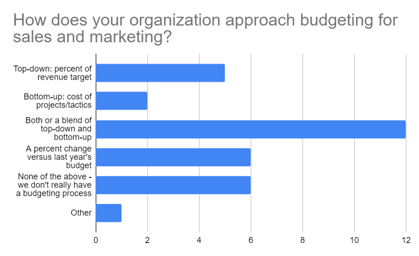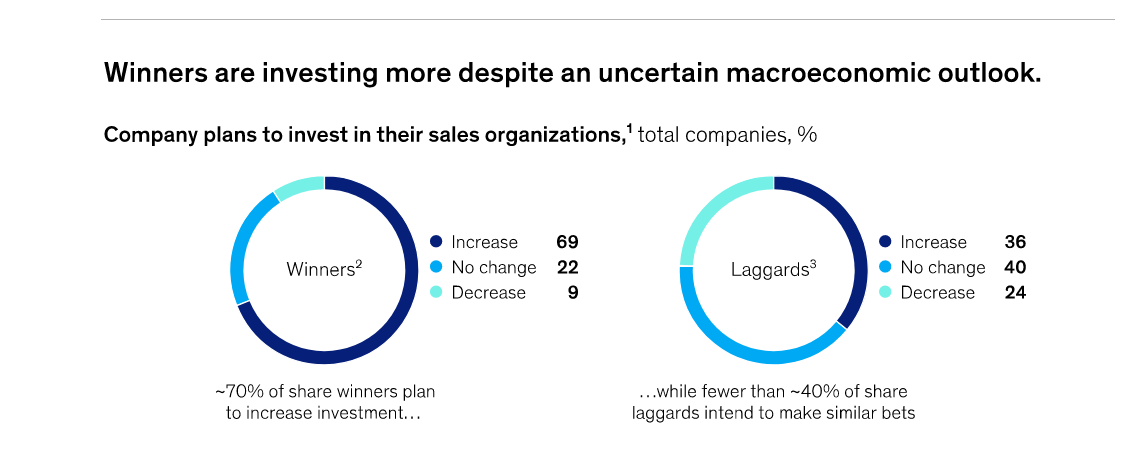Marketing KPIs & Benchmarks for 2026
We work with B2B leaders every day who have extensive marketing data, but don't know what to make of it. It's hard to know you're on track to meet...

For many, it’s budgeting season as companies work through their strategic plans for the coming year. This means something different in every B2B industrial company we surveyed:

Best practice suggests budgeting for marketing as a percentage of revenue target. Gartner research reports that marketing budgets have dipped to a post-pandemic low - however, there is a big difference between B2B and B2C spending - B2B spending is 8.4% of revenue, and B2C is 5.7%.

Marketing Budgets as Percentage of Total Revenue. Credit: Gartner
Budgeting as a percentage of revenue targets allows a company’s marketing efforts to scale to match growth targets and to build a suitable funnel to feed sales. This approach is founded on an outcome-based perspective: focused on ROI from the start.
It also helps to provide a foil to a ‘bottom-up’ cost-based approach to budgeting—to ensure appropriate prioritization and to leave room for experimentation and strategic investment.
According to McKinsey's pulse survey, companies gaining market share are increasing spending even in uncertain times:

Credit: McKinsey Pulse Survey
Today, 58% of CMOs report that their in-house teams lack the capabilities to execute their strategy. Given high turnover and a talent shortage, many will need to look to outsourced marketing partners, particularly in using AI, marketing data and analytics, customer understanding, customer journeys, and marketing technology.
Learn more about Launch's outsourced marketing capabilities!
Of the B2B industrial segments we serve, those with global reach, targeted approaches, and hardware-centric tech vary dramatically in their planning, company size and sophistication, and budgeting approach. The majority respond to current market conditions by increasing their investment in marketing to build their 2024 pipeline. The 9% guideline is appropriate for these segments, while SaaS software companies, in contrast, dedicate far more to marketing efforts given the nature of those companies’ cost structures.
The top-down, or percent of revenue target, approach is particularly useful to offset the ‘business as usual’ bias of costing, or ‘bottom-up’, or percent increase from the prior year. Both approaches put the emphasis on continuing the past year's activities, without properly assessing their effectiveness or ROI, and adding new activities and demands on already strained internal teams. It also does not allow for A/B testing, core investments in marketing technology, and brand building that will allow the organization to scale, and undervalues strategic marketing, in which the customer and market help to inform the company’s and technology’s direction.

In our client base, this resonates: trade shows are back, and companies are refreshing their approach and using these face-to-face events to build brand awareness and engagement, shifting lead generation online. Contrary to reports - email marketing is not dead! It is an efficient way to reach your audience (if you keep your database clean). Our clients often have very high engagement levels with their emails. Many of our clients are increasing their use of video - for marketing but also for early sales stages.
As you begin to plan your marketing strategy and marketing budget for 2024, here are some key takeaways:
Budget is intent. Not just a finance exercise, budget planning helps to establish your intentions, whether those be in entering new markets, building market share, or improving measurability. Your budget should reflect your goals.
Aim for a healthy mix. The higher the revenue target, the more diverse your marketing mix should be. Start-up companies with limited budgets must choose carefully where to invest and should think in terms of 3-4 cohesive campaigns, while more established companies should deliberately add channels to diversify their reach and improve their customer experience.
Plan for change. Scenario planning, A/B testing, and budget set-asides for opportunistic spending can help to hedge your bets during turbulent times.
It’s time for new tactics. This isn’t the year for ‘rinse and repeat.’ Add in elements of ABM, or Account Based Marketing, work through your approach to hybrid events, experiment with AI, hyper-personalization, and crystallize your brand story to clarify your value proposition in a changing market.
Where would your budget have the biggest impact? Ask for a marketing assessment to leverage the activities that are providing you with the best customer acquisition rate today and to gain fresh perspectives on areas of need.

We work with B2B leaders every day who have extensive marketing data, but don't know what to make of it. It's hard to know you're on track to meet...

Get a Competitive Edge with Comprehensive AI & GEO Insights If you are beginning to notice an erosion in organic traffic and leads, it may be time to...

Updated on 6/10/24 The 80/20 rule or Pareto principle, is a long-standing business strategy that a lot of companies are applying right now to...